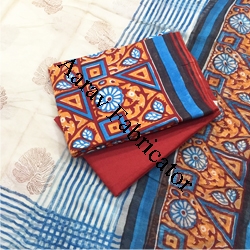Rajasthan is the hub of may artisans and craftsmen. Since long centuries it has been a pioneer in demonstrating arts of various kinds. Not just architecture, but there is an unseen side of Rajasthan which includes the production of different hand made products like pottery, quilts, sculptures, jootis and so on. These were some unique stuff which you’ll only find in Rajasthan. A bulk of tourists visit the state to specially shop and collect these souvenirs. The walled city area gives us the benefit of finding all this stuff under one roof.
Hand Block Printing Process
The traditional process of printing on textiles, with rich natural colors, has been practiced in Rajasthan for around 500 years. Block printing was introduced to the Jaipur region of Rajasthan by the Chhipa community. This community was originally located in Bagru Village, an area now famous for its vegetable dye and mud resist (dabu) block prints. The art of block printing has been passed down for generations within families and communities and has branched out in recent decades to other regions such as Sanganer, just South of Jaipur.
There are a number of stores in the indian handicraft sector which cater the needs of many consumers who are looking to buy hand block printed apparel. Any artisan or craftsman can easily get in touch with them by reaching out to them through their webpages.
To be the in demand craftsman, all you need is an out of the box artwork along with cheap selling prices strategy. These are the list of some of the best indian eCommerce stores which would easily add you to their list of vendors today.
How is block printing done on fabric?
The major tools used in the process of block printing are wooden blocks, fabrics and dyes. It involves the use of fabrics such as pure silk, pure cotton, crepe, georgette, chiffon and super net. The printer then uses these wooden blocks for producing patterns on the fabric. For this they cut the designs into blocks of different size and shapes which is further used by the carvers to create an intricate design. Usually it takes 5 carvers to complete this process done in up to 3 days. They use up to 30 wooden blocks to complete the whole design. Once the design is finished the fabric is treated for the dyes. Then are artisans dry the fabric in sun, then it is rolled in newspapers and steamed in special boilers. After steaming process, the fabric is washed, dried in the sun again, and ironed. This is how block printing is done on fabrics.
In recent decades, designers from the West have worked closely with local artisans to create Indo-Western styles which are inspired by other cultures, pop-art, nature and cityscapes. This collaboration has been beneficial for everyone as new designs emerge, but also it helps to tell the story of block printing and keep the market alive.
Social Impact on Culture
Block printing is typically done in open-air facilities in villages, or in people’s homes. It provides a source of income to many village families and is an environmentally positive approach to textile production in rural India. It is also a method of decentralized production, following Gandhi’s philosophy of keeping more people employed within their traditional environment.
While often men have been the printing masters, in small-scale, traditional production, women also become skilled printers. Traditional printing is often done in family units which provides more income for the whole family and allows women to work within the the day-to-day routine of family life.
Hand Block Printing on Attires
The major trendsetter of this game are Hand block printed salwar suits. Block printing process involves an enchanting sound which echoes through the village and is a reminder of the significance of artisan work.If you happen to visit any such village then you must see the process how Hand block printed salwar suits are created and designed by local artisans.
Above all, in an evolving global village where homogenous products dominate our lifestyles, craft products stand apart in their distinctiveness and cultural reference. Thus, by purchasing craft products allows consumers to buy quality products and also maintains a connection with their culture.

Your article has piqued a lot of positive interest. I can see why since you have done such a good job of making it interesting. Wholesale Kurtis by F3fashion
ReplyDelete